"Filling the Glass" - Early Two-Valve Mods
Page 1 of 1
 "Filling the Glass" - Early Two-Valve Mods
"Filling the Glass" - Early Two-Valve Mods
"Filling the Glass" taking the optimists view with the early two-valve 4.6's performance potential.
Text and photos by Richard Holdener - August 2007 5.0 Mustang & Super Fords (pages 54-66)
Text and photos by Richard Holdener - August 2007 5.0 Mustang & Super Fords (pages 54-66)
When reviewing the specs of the '96-'98 4.6 Two-Valve motor offered in the Mustang GT, it's easy to dismiss the original mod motor as nothing more than a stopgap replacement for the legendary 5.0. As you might imagine, following a motor that spawned an entire industry was a difficult task. History has shown hat filling those shoes--even half full--took more bullets than the new-fangled SOHC motor had in the clip. Mustang enthusiasts know the history of the mod motor and not three tears after its introduction, the original Two-Valve was replaced by a more powerful version.
The Power Improved (PI) Two-Valve motor offered a serious hike in performance finally pushing the GT motor beyond the power and performance offered by the original 5.0. Sure, the official 215hp rating of the '96-'97 motors was improved--or--re-rated--to 225hp in 1998, but the early Two-Valves never caught on with enthusiasts the way the 5.0 did. Even with the promise of improved efficiency offered by the aluminum heads and an overhead cam configuration, a drop in displacement from the torquey 5.0 seemed a hard pill to swallow.
Though bemoaned by enthusiasts who tend to see the performance glass of these early GT's as half empty, a second glance might actually reveal the glass is half full. Sure, these early motors offered a disappointing combination of lower compression, milder cam timing and an intake and head package that flowed considerably less than the '99-and-up PI motors. Rest assured: power is hiding in the early combination, begging to be unleashed. Oddly enough, it's the relative lack of performance that makes these early GT's so attractive. With the later PI Mustangs at a premium, the '96-'98 GTs cane had for a bargain.
Part of the bargain is the early 4.6's compression ratio. The '96-'98 motors relied on pistons with an 11cc dish to with with 51cc combustion chambers, producing a static compression of 9.3:1. The PI motors combined a 17cc dish with as smaller 42cc combustion chamber to produce 9.7:1. as luck would have it, the later PI heads are a direct bolt-on replacement, proving the late-model PI intake is included as well. While heads offer a flow improvement compared to the early versions, a substantial potion of the power gain offered by this swap comes from increasing the static compression from 9.3:1 using the 51cc chambers to 10.6:1. In addition to the hike in static compression, the PI heads also provide a much needed squish area, enhancing mixture motion to improve power and fuel economy, a larger exhaust valve, and the ability to flow even more with proper porting.
To maximize the performance potential of our PI head upgrade, we shipped the stock castings to Total Engine Airflow for the Stage 2 performance upgrade. The Stage 2 porting process was able to increase the flow rate of the stock PI heads from 176 cfm to 226 cfm, a gain of 50 cfm at a 0.600 valve lift. the exhaust flow was likewise improved, from 125 cfm to 209 cfm, a gain of 84 cfm.
Naturally, the PI heads required the use of the matching intake. The intake swap was not only required due to the difference in the intake port design between the heads, but it was actually beneficial, as the PI intake flowed significantly better than the '96-'98 version. Credit ports with a larger cross section and decreased runner length for the improvements, though the changes result in a slight drop in low-speed power compared to the original non-PI manifold. This is a minor trade off, given the impressive power available in the mid- to higher-rpm ranges (up to 6,000).
In truth, the PI head swap was part of the upgrade package we had in store for he '97 motor, which we pulled from the engine bay of a mangled Mustang. The high-mileage modular was anything but spectacular, offering nothing more than even compression on all cylinders. In short, the motor was what you would expect to find under the hood in almost any potential project Pony.
In addition to the PI induction system, we took the opportunity to bless the stepchild Tw-Valve with a set of performance cams. Straight from the Comp Cams catalog, the XE270AH version offered a 0.550 lift, dual-pattern duration specs of 234/238 degrees at 0.050, and a 113-degree lobe separation angle. The high lift allowed us to take full advantage of the airflow offered by the ported PI heads, while the duration changed shifted the torque curve to greatly improve the peak power numbers.
While the Comp Xtreme Energy cams, TEA-ported PI heads, and matching PI intake were the highlights of the performance upgrades, a few other modifications were present to further improve the power output over stock. On the induction side, we relied on a 75mm throttle body and inlet elbow from Accufab. Since the motor was run on the rngine dyno, no accessories or further induction system were necessary. On the dyno, the motor was programmed with a FAST engine management system, allowing us to eliminate the induction system from the airbox back to the throttle body. In the end, we relied on a simple induction tube with a radiused entry on the stock and modified motor configurations.
Running a Meziere electric water pump allowed us to eliminate the usual array of accessories. Naturally, this had a positive effect on power production , but the engine enjoyed the benefits of running without accessories and factory induction in stock and modified trim. The final modification was to install a set of Hooker long-tube headers. Actually, the headers were used in stock trim as well, as this simplified exhaust routing on the dyno. All we had to do after installing the stock '97 motor on the dyno was establish a baseline, install the performance upgrades and run it one final time.
After filling the crankcase with 5W-30 Lucas synthetic oil and careful tuning of the '97 Two-Valve motor, we were rewarded with baseline numbers of 258 hp at 4,800 rpm and 341 lb-ft of torque at 3,500 rpm. The combination of long-tube headers, small head ports and mild cam timing produced relatively impressive low-speed torque production, with the 281 ci motor producing more than 300 lb-ft of torque from 2,500 rpm to 4,500 rpm. Unfortunately, this combination greatly limited power production at the top of the rev range. Once the power curve reached 4,000rpm, it leveled off until 5,200 rpm. The result was a flat power curve for a solid 1,200 rpm spread. It should be noted that the difference between the rated power output of 215 hp and the numbers produced on the dyno can be attributed to the lack of accessories, a low-restriction induction, an open exhaust system, and the maximized performance tune provided by the FAST system. We also ran this motor with long-tube headers at a water temperature of 150 degrees, where the rated power output comes at normal operating temperature. Regardless of the power numbers generated by the fyno, we were looking for a difference from out performance modifications.
After backup runs repeated the baseline power numbers, the stock heads, intake and camshafts came off. They were replaced by the TEA-ported PI heads, a matching intake manifold, and Xtreme Energy cams. The Accufab 75mm throttle body, Hooker long-tube headers and 19-pound injectors were retained from the previous test, though we increased the static fuel pressure by nearly 20 psi for the test. To properly secure the new TEA heads, we elected to replace the factory head gaskets with MLS gaskets from Fel-Pro. They were clamped in place using a set of ARP head studs. With a bit of overkill for this normally aspirated application, they would come in handy once we applied boost from out Vortech supercharger.
The PI components lived up to their names, as the ported heads, cams and intake increased the power output of our '97 Two-Valve motor from 258 hp and 341 lb-ft of torque to 401 hp and 390 lb-ft of torque. The graph tells the whole story; instead of leveling off at 4,000 rpm, the new components allowed the motor to pull strongly to 6,000 rpm. Thanks primarily to the wilder cam timing, there was a slight from in power below 3.5000 rpm, but the gains from 3,500 rpm all the way to 6,000 rpm were tremendous. Imagine: the heads, cam and intake improved the power output of this early Two-Valve motor by 143 hp. How full does that glass look now?
While the gains offered by the top-end package were impressive. there was more power to be had with the introduction of forced induction. Turning to Vortech, we opted to install one of the company's 4.6 GT kits that included an air-to-water intercooler system. Though we purposely limited the boost level with the stock short-block (cast pistons), we deemed the charge cooler necessary due to the elevated compression ratio of our hybrid PI motor. We also took the liberty of adding a can of Lucas Oil octane booster to the Rocket Brand premium unleaded pump gas.
We installed the Vortech supercharger on the awaiting motor using a combination of the factory crank, and 3.33-inch blower pulley. The net result was a maximum boost level of 10.9 psi at 6,400 rpm. Running dyno water through the charge cooler, the supercharged combination produced 648 hp and 543 lb-ft of torque. From the looks of the power curve, had we not limited our high-mileage, stock short-block to 6,500 rpm, the power curve would still climb rapidly. With a more aggressive tune (more timing), a cooler charge from ice water, and elevated engine rpm, his could be one serious motor. We certainly recommended forged internals for such an exercise. As it is, any glass that contains an early Two-Valve 4.6 motor that pumps out nearly 650 hp is neither half empty nor half full-- it's completely full.
 Re: "Filling the Glass" - Early Two-Valve Mods
Re: "Filling the Glass" - Early Two-Valve Mods
I have typed up this article and added links to various products that we used in this. Here are copies of the scanned article from the magazine.
1
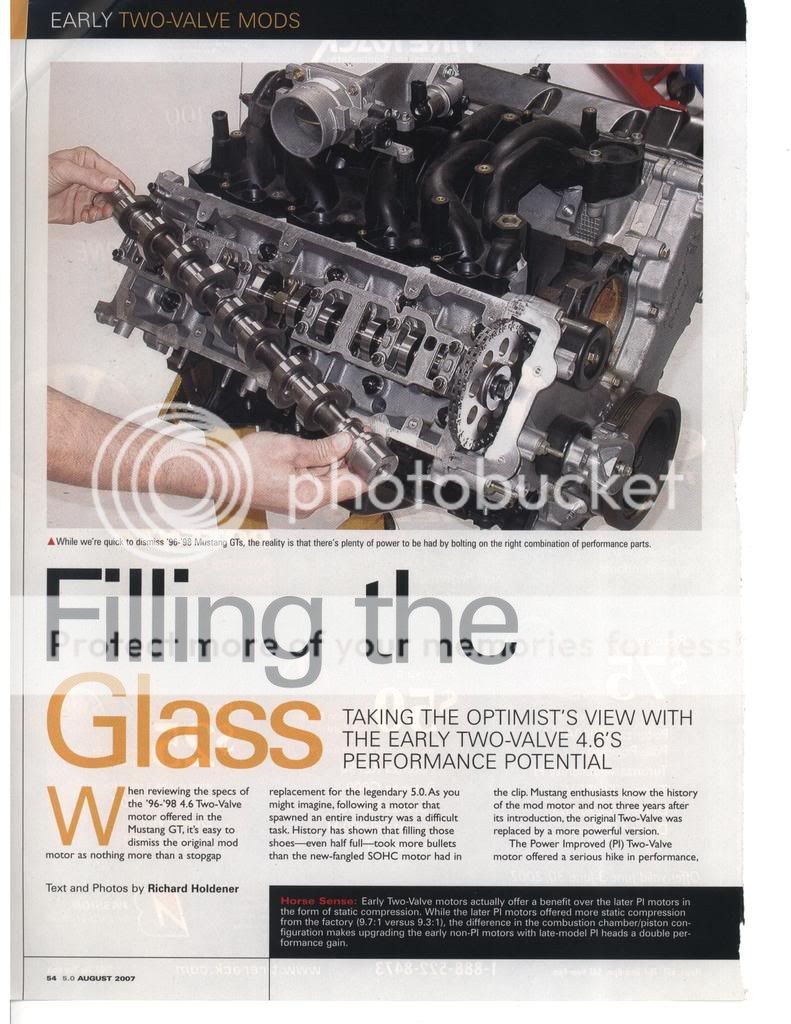
2

3

4
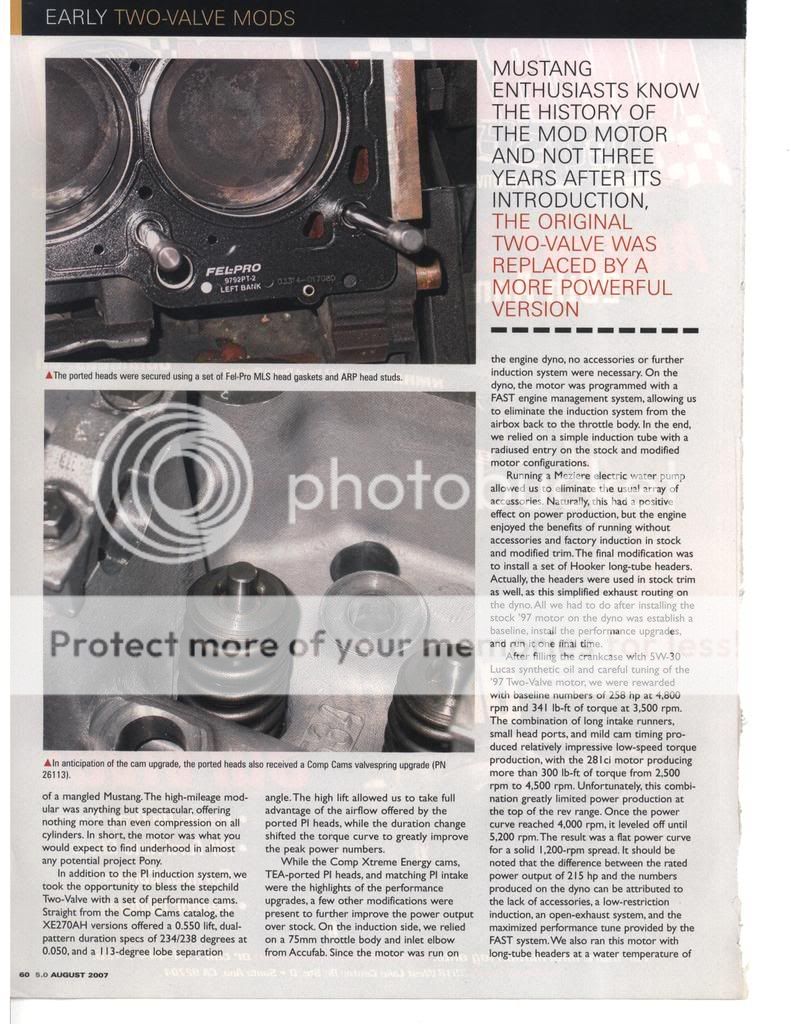
5
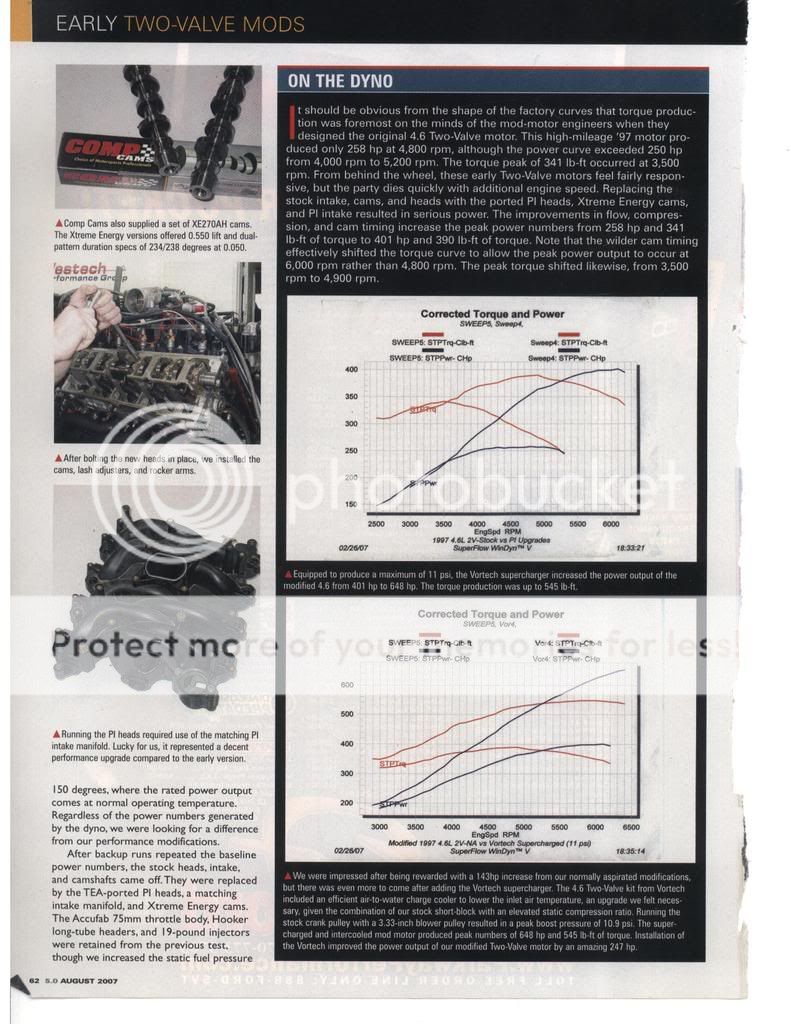
6
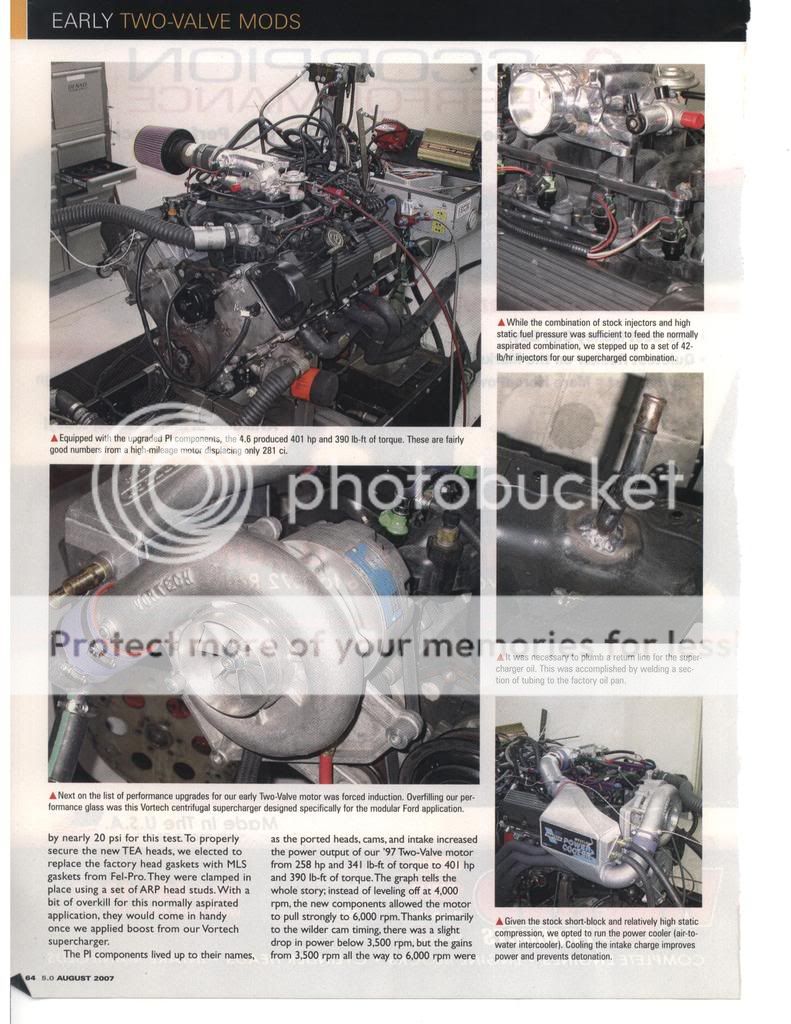
7
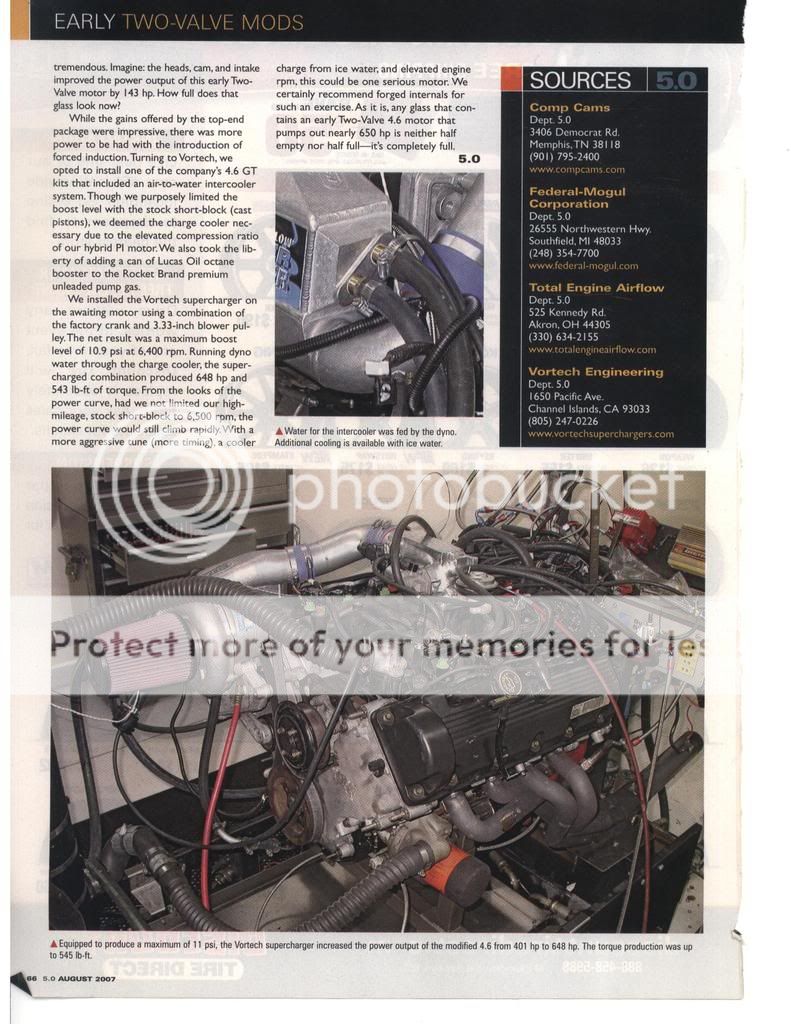
1

2

3

4

5

6

7

 Re: "Filling the Glass" - Early Two-Valve Mods
Re: "Filling the Glass" - Early Two-Valve Mods
I took the time to do this because I hold this article in high regard to what can be done with the '96-'98 Mustang GT's and this is exactly what I am going to do with my engine but I will rebuild mine with new, stronger internals. They didn't do that for this article.
 Similar topics
Similar topics» Glass Car Commercial
» WTB: Early 90's F150
» Replacement sideview mirror glass
» New Shoes "ON", Struts, Shocks, and CC Plts
» Oppose Federal "Cash for Clunkers" Program
» WTB: Early 90's F150
» Replacement sideview mirror glass
» New Shoes "ON", Struts, Shocks, and CC Plts
» Oppose Federal "Cash for Clunkers" Program
Page 1 of 1
Permissions in this forum:
You cannot reply to topics in this forum
 Chat
Chat